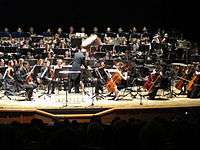Youth orchestra

A youth orchestra is an orchestra made of young musicians, typically ranging from pre-teens or teenagers to those in their mid-20s. Because young children do not usually start playing double bass until a later age than those playing the smaller instruments, double bass players in youth orchestras tend to be in the early to mid-20s. The typical youth orchestra involves members from across an entire city or town. In some cases, there are national youth orchestras, which consist of the best young musicians in a country, as determined by auditions. More rarely, there may even be international youth orchestras. Youth orchestras are led by an adult conductor who is often a music teacher or orchestral musician. In addition to leading the rehearsals and performances, the conductor teaches orchestral playing techniques, performance practice and music ensemble skills to the children and youth.
Instructional elements
While a professional orchestra will receive the parts and have a few days of rehearsal, and then play several performances, in a youth orchestra, the ensemble rehearses the concert program for several months. This additional time gives the conductor lots of time to coach the orchestra and teach them how to learn the many skills required of a skilled large ensemble player, which include:
- Playing the notated melody lines, accompaniment parts and bass lines with correct notes (avoiding transposition errors, incorrect accidentals, wrong notes, and so on);
- Playing with correct intonation (tuning) and correct rhythms;
- Playing with good "ensemble", which means playing the rhythms together as a group, a task which is made challenging by the frequent use of accelerando (speeding up) and ritardando (slowing down) passages in classical orchestral music.
- Learning to watch the conductor's baton, face, hands and arms during the performance, as this is how the conductor starts and stops pieces, indicates "cues" and tempo, and indicates the dynamics and phrasing;
- Learning to play parts with the standard phrasing expected in classical music melodies from different eras;
- Learning to prepare orchestral parts through individual practice at home, with the goal of learning all of the challenging "passagework", exposed passages and solos;
- Learning where to mark in fingerings and indications of tempo changes, fermatas, etc. in the part in pencil. One important skill for young players to learn is to write in how each movement is conducted (e.g., a movement in 6/8 may be conducted in "two", which is two beats per bar, or in "six", six beats per bar, or even in "three", three beats per bar);
- Learning to develop the physical endurance and attention span to play an entire concert program and remain focused;
- Learning how to simultaneously be aware of the conductor, the concertmaster (principal first violin, the leader of the musicians) and the section leader/principal player in her section;
- Developing the confidence to play in front of large audiences on stage, dealing with stage fright or "nerves" and acting in a professional manner while on stage;
- Learning to know how to determine whether one's part is a main part (e.g., principal theme or melody) or an accompaniment part, and adjust the volume and tone accordingly;
- Learning to play different articulations and note lengths to match those of the concertmaster and/or section leader, as instructed by the part, or by the conductor;
- Learning to play with choirs and accompany solo singers. This may involve learning to be directed by choir conductors and learning how to accompany solo singers, which requires orchestral members to colla parte, that is follow along the vocals of the singer, paying close attention to changes in tempo and pauses, and play in most cases with a lower dynamic than she would use in a regular orchestra performance;
Repertoire
Like professional orchestras, youth orchestras play concert programs that focus on the standard orchestral repertoire, such as overtures, concertos (usually with a skilled youth orchestra member playing the solo, while their colleagues play the orchestral parts), and symphonies.
Notable youth orchestras
Notable youth orchestras include:
Australia
- Adelaide Youth Orchestra
- Melbourne String Ensemble
- Queensland Youth Orchestras
- SBS Radio and Television Youth Orchestra
- Sydney Youth Orchestra
Europe
- European Union Youth Orchestra
- European Union Baroque Orchestra
- Galway Youth Orchestra
- Gustav Mahler Youth Orchestra
- Internationale Junge Orchesterakademie
- Jeunesses Musicales World Orchestra
- Junges Klangforum Mitte Europa
- Kremerata Baltica
- Stockholm Youth Symphony Orchestra
United Kingdom
England:
- CBSO Youth Orchestra
- City of Sheffield Youth Orchestra
- Colne Valley Training Orchestra
- Colne Valley Youth Orchestra
- London Schools Symphony Orchestra
- Nottingham Youth Orchestra
- Reading Youth Orchestra
- Somerset County Youth Orchestra
- South Tyneside Youth Orchestra
- Stockport Youth Orchestra
- Suffolk Youth Orchestra
- Tees Valley Youth Orchestra
- Wessex Youth Orchestra
Scotland: